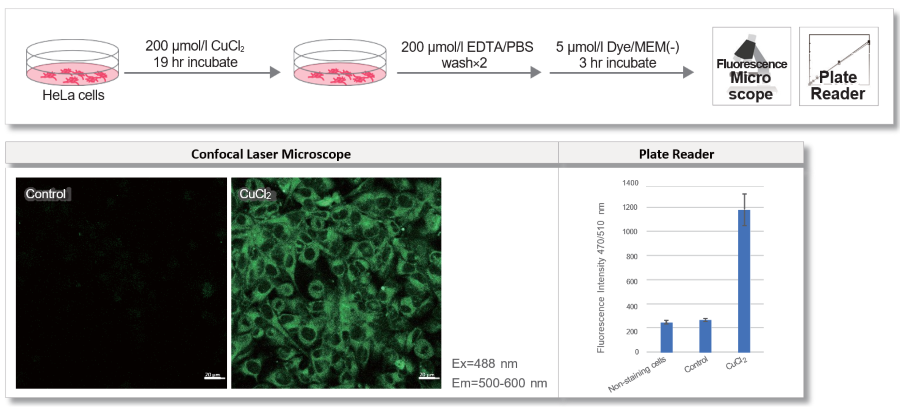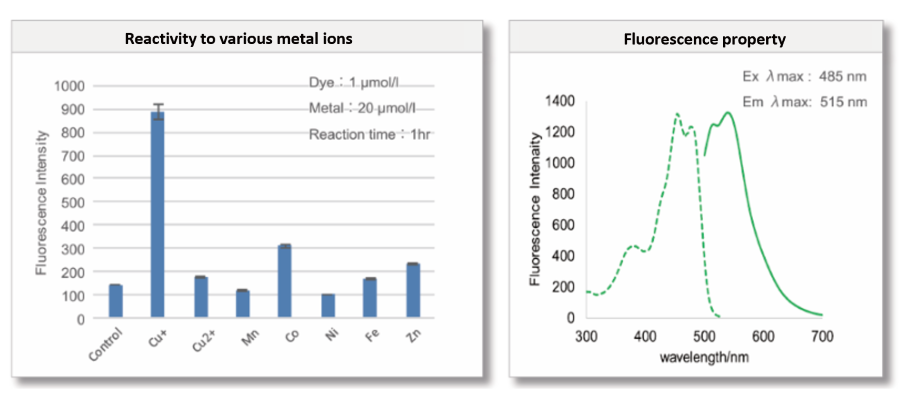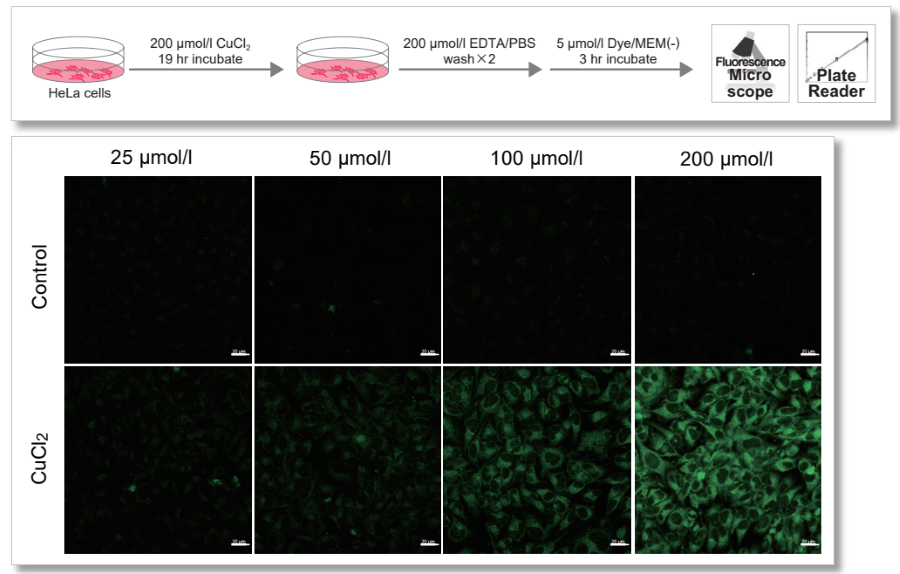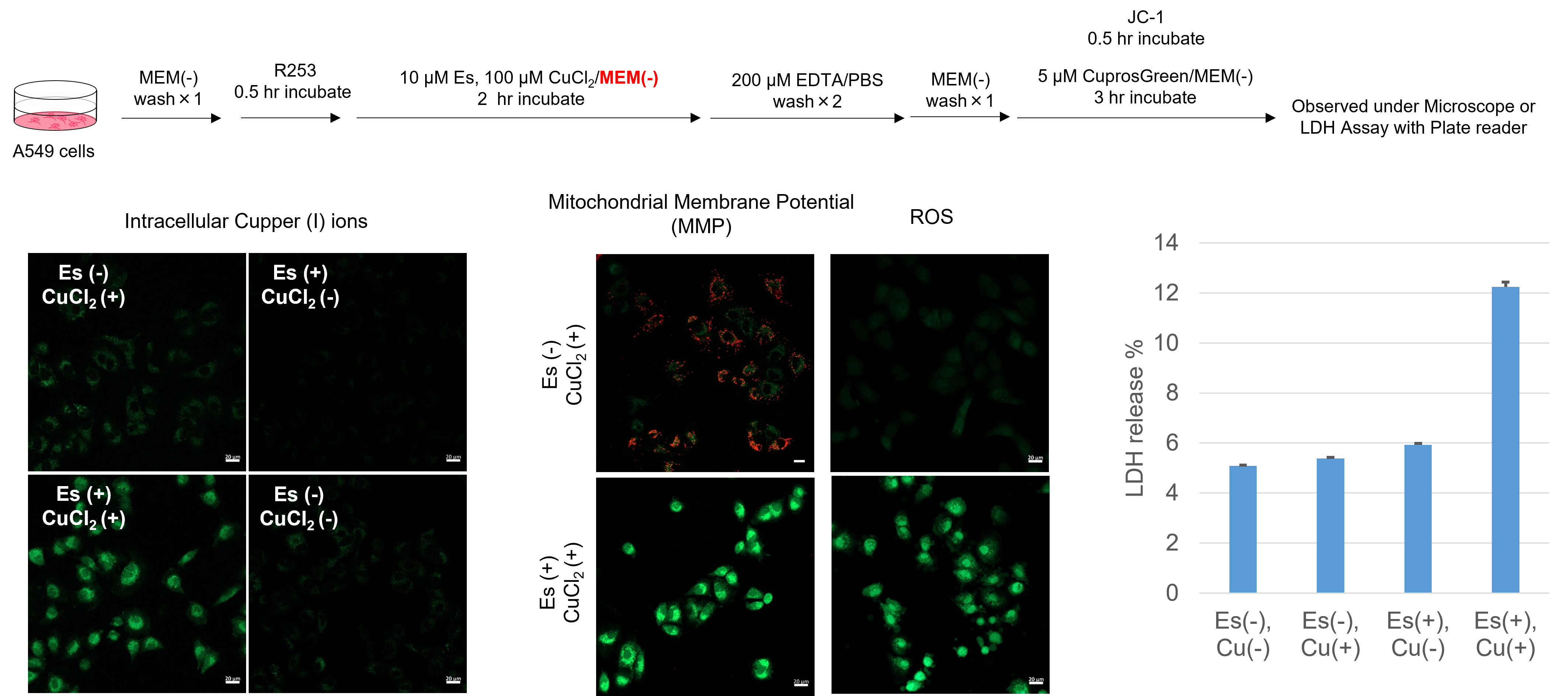CuprosGreen

Live-cell imaging of copper (I) ions
- Selective detection of intracellular monovalent copper ions
- Microscopic observation and plate reader detection possible
- Easy-to-use solution type, no need for dissolution process
-
Product codeC557 CuprosGreen
| Unit size | Price | Item Code |
|---|---|---|
| 20 μl | Find your distributors | C557-10 |
Role of Copper Ions
Copper is known as a transition metal that acts as the active centre of enzymes that control vital processes such as respiration and metabolism, although it is only present in trace amounts in the body. Specifically, copper assists binds to superoxide dismutase1 (SOD1), thereby scavenging reactive oxygen species (ROS). Copper thus plays an important role in maintaining life.
In recent years, copper has also been the focus of research into cell death. While much research has been done on ferroptosis, a relatively new pathway of cell death initiated by iron (II) ions, a new pathway of cell death initiated by copper (I) ions, distinct from ferroptosis (cuproptosis), has been discovered1). CuprosGreen is a fluorescent probe that selectively reacts with intracellular copper (I) ions and emits fluorescence. Its membrane permeability allows live-cell imaging of copper (I) ions.
1) Tsvetkov et al., Science, 2022, 375, 1254–1261
This product was developed under the guidance of Professor Masayasu Taki of Gifu University.
For imaging with fluorescence microscopy and quantifying with a plate reader
In HeLa cells, we evaluated changes in intracellular CuCl2 addition (which is reduced intracellularly to monovalent copper ions) and found that CuCl2 addition increased intracellular monovalent copper ion levels compared to control by both confocal microscopy and plate reader detection methods.

Manual
Technical info

Detection of CuCl2 concentration-dependent changes in intracellular monovalent copper ion content
We evaluated concentration-dependent changes in intracellular CuCl2 levels in HeLa cells and observed a concentration-dependent increase in intracellular CuCl2 levels upon CuCl2 addition compared to control by confocal microscopy.

Experimental example: induction of Cuproptosis using the copper ionophore Elescolmol.
Elesclomol is a potent copper ionophore that enhances the cellular uptake of Cu2+ and promotes copper-dependent cell death (cuproptosis).
A549 cells were treated with CuCl2 and elesclomol to induce cuproptosis and intracellular monovalent copper (CuprosGreen), mitochondrial membrane potential (JC-1 MitoMP Detection Kitt) and intracellular ROS (ROS Assay Kit -Photo-oxidation Resistant DCFH-DA-) and extracellular LDH (Cytotoxicity LDH Assay Kit-WST) were measured as indicators of cell death. The results showed that intracellular monovalent copper was greatly increased in combination with elesclomol than with CuCl2 treatment alone, and a concomitant decrease in mitochondrial membrane potential was observed. In addition, intracellular ROS and extracellular LDH were significantly increased in the combined CuCl2 and elesclomol treatments, confirming the induction of caprotosis.

References
| No. | Sample | Instruments | Publications |
|---|---|---|---|
| 1) | HeLa cell | Microscope |
Taki, M., Iyoshi, S., Ojida, A., Hamachi, I., Yamamoto, Y.,"Development of Highly Sensitive Fluorescent Probes for Detection of Intracellular Copper(I) in Living Systems", J. Am. Chem. Soc. 2010, 132, 17, 5938–5939. DOI: 10.1021/ja100714p |
Q & A
-
Q
Why is it necessary to use serum-free medium for the working solution?
-
A
Preparation of CuprosGreen in serum containing medium at the time of staining will result in lower fluorescence intensity; for optimal performance of CuprosGreen we recommend preparation in serum free medium.
-
Q
Is it possible to prepare the working solution in PBS or HBSS?
-
A
The incubation time for CuprosGreen is 3 hours and it is recommended that it is prepared in serum-free medium to reduce cytotoxicity caused by prolonged incubation.
-
Q
Why does the protocol state that cells should be observed after staining without washing?
-
A
CuprosGreen dye diffuses during washing.
To optimise the performance of CuprosGreen, it is recommended to observe without washing.
-
Q
Are there any precautions with the dilution of CuprosGreen DMSO solution?
-
A
If CuprosGreen DMSO solution is added to serum-free medium, CuprosGreen may precipitate in the medium. Ensure that the working solution is prepared by adding additional DMSO and serum-free medium to the CuprosGreen DMSO solution.
Handling and storage condition
| Appearance: | Colorless to slightly brown liquid |
|---|---|
| Dye content: | To pass test |
| Store at -20 °C, protect from light |









